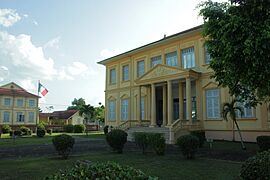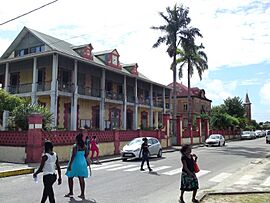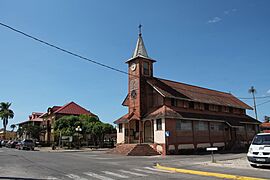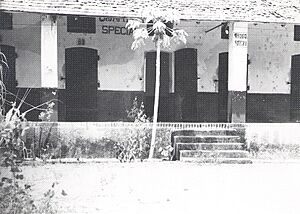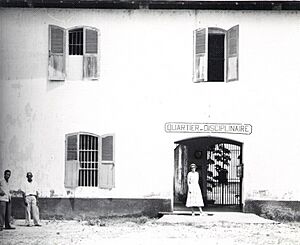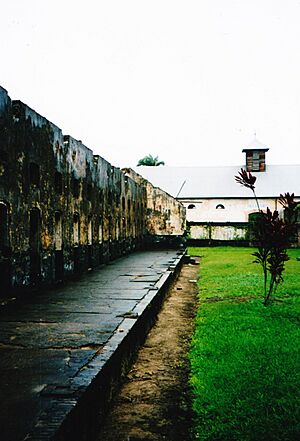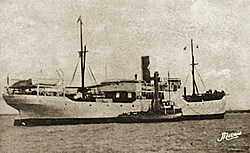Saint-Laurent-du-Maroni facts for kids
Saint-Laurent-du-Maroni is a town in French Guiana, which is an overseas region and department of France. It's located in South America. Saint-Laurent-du-Maroni is one of the main administrative centers in French Guiana and is the second largest city there. In January 2021, about 50,250 people lived in Saint-Laurent-du-Maroni. Its name means "Saint-Laurent of the Maroni River". In French Guianese Creole, it's called Sen-Laurent-di-Maronni.
Quick facts for kids
Saint-Laurent-du-Maroni
|
||
|---|---|---|
|
Subprefecture and commune
|
||
|
From top to bottom: subprefecture building, city hall, main Catholic church of Saint-Laurent-du-Maroni
|
||
|
||
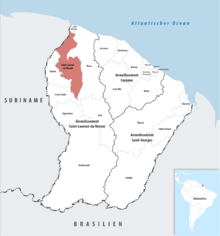
Location of the commune (in red) within French Guiana
|
||
| Country | France | |
| Overseas region and department | French Guiana | |
| Arrondissement | Saint-Laurent-du-Maroni | |
| Intercommunality | Ouest Guyanais | |
| Area
1
|
4,830 km2 (1,860 sq mi) | |
| Population
(2021)
|
50,250 | |
| • Density | 10.404/km2 (26.946/sq mi) | |
| Time zone | UTC−03:00 | |
| INSEE/Postal code |
97311 /97320
|
|
| 1 French Land Register data, which excludes lakes, ponds, glaciers > 1 km2 (0.386 sq mi or 247 acres) and river estuaries. | ||
Contents
History of Saint-Laurent-du-Maroni
Saint-Laurent-du-Maroni was started in 1858 by a person named Auguste Baudin. It was once the main arrival point for prisoners sent to French Guiana. They arrived at a place called the Camp de la Transportation, which was a large prison camp.
The town was built near an Amerindian village called Kamalakuli. This village was named after its chief. On September 15, 1880, Saint-Laurent-du-Maroni became a special town just for the prison. The person in charge of the prison was also the mayor of the town.
Later, in 1932, a politician named Gaston Monnerville was elected. He worked to close the prison system. The prison was officially stopped on June 17, 1938, but it didn't fully close until 1946. Finally, on November 9, 1949, Saint-Laurent-du-Maroni became a regular town, like any other in France.
Geography and Location
Saint-Laurent-du-Maroni is a town located in the northwest part of French Guiana. It sits right on the Maroni River. Across the river is the town of Albina in Suriname. You can travel between the two towns by ferry or a small boat called a pirogue.
The town does not have a coast on the Atlantic Ocean. This might have been chosen on purpose. The prison authorities wanted to make it harder for prisoners to escape by sea from the Prison of St-Laurent-du-Maroni.
People Living in Saint-Laurent-du-Maroni
Like other places in French Guiana, Saint-Laurent-du-Maroni has many different groups of people. The largest group today are the Maroons. After them are the Creoles, Amerindians, people from Haiti, people from mainland France, and people from Brazil.
Most Maroons live in areas like la Charbonnière (which includes Djukas, Saramakas, and Paramaccans), les Vampires, and les Sables Blancs. Amerindian people live in villages outside the town, such as Balaté (Arawaks), Paddock, Prospérité, Terre Rouge, Espérance, and Village Pierre (Kalinas).
Population and People
Historical Population Growth
The number of people living in Saint-Laurent-du-Maroni has grown a lot over the years. Here's how the population has changed:
| Historical population Saint-Laurent-du-Maroni | |||||||||||||||||||||||||||||||||||||
|---|---|---|---|---|---|---|---|---|---|---|---|---|---|---|---|---|---|---|---|---|---|---|---|---|---|---|---|---|---|---|---|---|---|---|---|---|---|
|
|
||||||||||||||||||||||||||||||||||||
| Source: SPLAF, INSEE, Brasseur | |||||||||||||||||||||||||||||||||||||
Where People Are Born
In 2015, there were 43,600 people living in Saint-Laurent-du-Maroni. Here's where they were born:
- 64.1% were born in French Guiana.
- 5.3% were born in mainland France.
- 0.9% were born in Martinique.
- 0.5% were born in Guadeloupe.
- 0.2% were born in other parts of Overseas France.
- 29.0% were born in other countries. Most of these came from Suriname, then Brazil, and then Haiti.
Environment and Nature
Saint-Laurent-du-Maroni is home to an important group that works to protect nature. This group is called "Le pou d'agouti". It's named after a small local insect that causes an itchy bite! The group works hard to protect the animals and plants in the area.
The town is also a starting point for many ecotourism trips. Ecotourism means traveling to enjoy nature in a way that protects it. You can take boat trips up the river to explore small creeks and the amazing Amazonian rainforest. Some tours even let you spend a night in the jungle in huts or tents. Another fun place to visit is the Voltaire Falls, which are about 70 kilometers (43 miles) upriver.
Sadly, some human activities have caused damage to the environment around the town. These include growing industries, more buildings being built, and illegal hunting. However, new discoveries are still being made! For example, in 2009, a type of Caecilian (a legless amphibian) that no one had ever seen before was found right in the town.
Transportation and Travel
In the past, from 1890 to 1897, a 16-kilometer (10-mile) railway was built between Saint-Laurent-du-Maroni and Saint-Jean-du-Maroni. Another 22-kilometer (14-mile) railway went to a sawmill. These railways were stopped after the prison camps closed.
Today, you can mostly reach Saint-Laurent-du-Maroni by road, using Route Nationale 1 from Cayenne. A new port was built on the Maroni River, but it still needs better docks and deeper water for ships. The old Saint-Maurice airfield is now used for sports. There's also a road that connects Saint-Laurent to Saint-Jean-du-Maroni and its military base.
In 2010, a new part of Route Nationale opened. It connects Saint-Laurent-du-Maroni to Apatou. This road was opened during the "Tour of Guiana" event. Plans are in place to extend this road even further to Maripasoula. Construction on the part between Apatou and Papaïchton is set to begin in 2021.
The town is also a key place to start trips inland by pirogue (a small boat). You can also take a ferry or pirogue across to Albina in Suriname. The town's Saint-Laurent-du-Maroni Airport has flights from Air Guyane Express.
Economy and Local Products
Near the town, there are fields of sugarcane. This sugarcane is used to make a famous rum called "La Belle Cabresse" by the Saint Maurice rum company. They also make other rums like "La Cayennaise" and "Cœur de Chauffe". This rum is quite strong, usually 50 to 55% alcohol, and is known for its good quality.
On the road to Saint-Jean-du-Maroni, which is about 17 kilometers (11 miles) south of Saint-Laurent, you can find many small shops. These shops are owned by Saramaka people. They sell beautiful wooden crafts that they are famous for, especially chairs and tables. There is also a village of Maroon artists on the road to Javouhey.
Two military groups are based at Camp Némo in St-Jean. One is the Groupement du service militaire adapté (GSMA). This group helps young people in western French Guiana get job training. The other is a part of the 9th Marine Infantry Regiment. Their job is to patrol the river border and the jungles in the west of the department. In 2008, these two groups joined together to form the Regiment of the Adapted Military Service (RSMA).
Interesting Places to Visit
Many old official buildings in Saint-Laurent-du-Maroni were originally built by the French prison system. These buildings have a special look, mixing colonial style with prison architecture. Prisoners used local red clay bricks to build a whole area of official buildings. The main prison itself, the Camp de la Transportation, was one of the first.
This old administrative area is sometimes called Le Petit Paris (Little Paris) because it reminds some people of French architecture from the 1800s. Here are some of the main buildings you can see:
- Le Camp de la Transportation: You can take guided tours here and see the famous cell of Henri 'Papillon' Charrière. The Tourist Office is also nearby.
- La Résidence du Gouverneur du bagne: This was where the prison governor lived. Today, it's the home of the local government official called the sous-préfet.
- Le Tribunal maritime: This used to be the maritime court. Now it's the sous-préfecture building.
- La Mairie: This is the city hall, and the old bank building is next to it.
- St. Lawrence Church.
- Le Trésor public: This was the public treasury.
- L'Hôtel La Tentiaire.
- La caserne Joffre: This was the main police (Gendarmerie) headquarters.
- André-Bouron Hospital: This hospital was used until September 2018.
Most of these buildings are located on Avenue De Gaulle, Avenue Lieutenant-Colonel Tourtet, and Boulevard Mallouet. After the prison closed in the early 1950s, these buildings were not taken care of and were damaged by the weather. They were almost completely ruined. However, in the early 1980s, the city and the French Minister of Culture realized how important these old buildings were. They started a big project to fix them up. Now, this old prison and administrative area is a major tourist spot, with the Camp de la Transportation being the most popular attraction.
Other interesting places from the prison years include Saint-Jean-du-Maroni. This was once the Camp de la Relégation (a type of prison camp) and is now the main military base for western French Guiana. There's also a small island in the Maroni River that used to house prisoners who had leprosy. Papillon wrote about hiding there during one of his escape attempts.
There are also interesting sights not related to the prisons:
- La Charbonnière: This is a Maroon village started by people who sought safety from a civil war in Suriname.
If you visit, there are many hotels in Saint-Laurent-du-Maroni, such as the Auberge Bois Diable, Chez Julienne, Hôtel la Tentiaire, Le Relais des 3 Lacs, and Star Hôtel.
Climate and Weather
Saint-Laurent-du-Maroni has a tropical rainforest climate. This means it's hot and rainy all year round. The temperatures stay pretty much the same throughout the year. The average low temperature is around 24°C (75°F), and the average high is around 29°C (84°F). In September and October, which are the driest months, the average high can be a bit warmer, around 31°C (87°F).
The town gets a lot of rain every month, at least 100 millimeters (4 inches). This is different from the south and east of French Guiana, where September and October are usually drier. On September 27, 2016, Saint-Laurent-du-Maroni recorded a temperature of 38.0°C (100.4°F). This is the highest temperature ever recorded in French Guiana!
| Climate data for Saint-Laurent-du-Maroni | |||||||||||||
|---|---|---|---|---|---|---|---|---|---|---|---|---|---|
| Month | Jan | Feb | Mar | Apr | May | Jun | Jul | Aug | Sep | Oct | Nov | Dec | Year |
| Mean daily maximum °C (°F) | 28 (82) |
28 (82) |
28 (83) |
28 (83) |
28 (83) |
28 (83) |
29 (84) |
30 (86) |
31 (87) |
31 (87) |
29 (85) |
28 (83) |
29 (84) |
| Mean daily minimum °C (°F) | 24 (75) |
24 (75) |
24 (76) |
24 (76) |
24 (76) |
24 (75) |
24 (75) |
24 (76) |
24 (76) |
24 (76) |
24 (75) |
24 (75) |
24 (75) |
| Average rainfall mm (inches) | 260 (10.3) |
180 (7.1) |
190 (7.6) |
240 (9.5) |
350 (13.6) |
330 (13) |
250 (9.7) |
170 (6.8) |
110 (4.5) |
100 (4) |
160 (6.3) |
250 (9.7) |
2,590 (102.1) |
| Source: Weatherbase | |||||||||||||
Notable People from Saint-Laurent-du-Maroni
Many interesting people have come from Saint-Laurent-du-Maroni, including:
- Lénaïck Adam (born 1992), a politician.
- Léon Bertrand (born 1951), a politician and former mayor.
- Raoul Diagne (1910–2002), a famous footballer.
- Sonia Francius (born 1979), a civil servant.
- Oriane Jean-François (born 2001), a footballer.
- Florian Jozefzoon (born 1991), a footballer.
- Stéphane Martine (born 1978), a footballer.
- Raymond Tarcy (1936–2019), a politician and senator.
Nearby Villages
Several villages are located near Saint-Laurent-du-Maroni:
- Balaté, a Lokono village.
- Espérance, a Kalina village.
- Île Portal, an island in the Maroni River.
- Saint-Jean-du-Maroni, a village within the commune of Saint-Laurent-du-Maroni.
See also
 In Spanish: San Lorenzo de Maroni para niños
In Spanish: San Lorenzo de Maroni para niños


